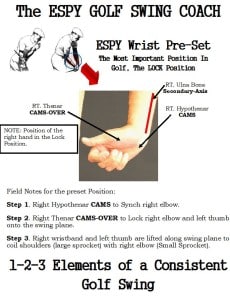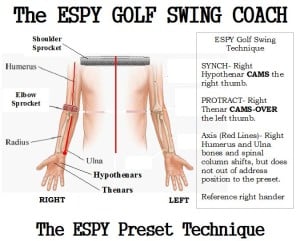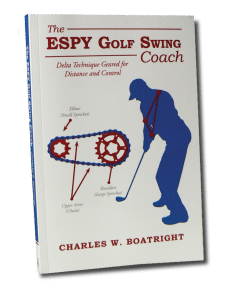
By Charles W. Boatright
Using the Chippendale Technique to Improve your Golf Game
One method for fine-tuning your golf swing techniques and mechanics is with a scaled-down version of the full golf swing called the Chippendale Technique. If the golfer can engage three of their five senses (touch, sight, sound) in their golf swing, they can dramatically improve the fundamentals of their game. The scaled-down Chippendale golf swing is essentially small ball, or an abbreviated soft chip or pitch golf shot that I discuss in my book, The ESPY Golf Swing Coach, in Sections 3.0, 12.0, and 13.0, to improve the golfer’s feel or touch during the golf shot.

Last year, LSU’s baseball team was visiting the Arkansas Razorbacks at Baum Stadium, on March 20, 2015. You did not have to watch past the fourth inning to realize that LSU had a different approach to the batting philosophy. LSU had some of the best batting coaches in college sports, with Javi Sanchez up to the end of the 2014 season and starting the 2015 season with Andy Cannizaro. Their batting approach would be considered small ball philosophy in baseball to increase their BA, or batting average, and OBA, or on-base average.
Small ball is more of a mental, disciplined approach to hitting. Like golf, your tendency is to rely on the physical component. Yogi Berra had a great quote for this tendency– You don’t have to swing hard to hit a home run. If you got the timing and technique, it will GO“. My grandfather, my golf coach– The Great Qatspy, added the phrase (and technique) to Yogi’s quote. In small ball, the batter is just trying to get the ball in play and on-base, not to get a double, triple, or home run. The results of small ball approach were obvious, with a 16 to 3 win over Arkansas by LSU. Arkansas was swinging for the fence on the majority of at-bats.
As proven with statistics from the NCAA golf tournaments, if the golfer wants to improve their golf game, they want to improve their approach shot into the green. The average NCAA golfer (both men and women):
- Hits 72 percent of their fairways.
- Hits 51 percent of their greens-in-regulation.
- Makes 99 percent of their putts inside 3 feet.
- Makes 69 percent of their putts inside 6 feet.
- Makes 54 percent of their putts inside 8 feet.
- Makes 31 percent of their putts between 10 to 15 feet.
I have a 405- Training Drill that I use during my practice sessions or training work. My aim is to make 4 golf shots Out of 5 to a designated area, usually a 12- foot diameter area from tee to green. This allows me to work toward an 80 percent accuracy rate.
If the golfer could improve their approach shot of landing their approach shot within six-feet of the hole, they would have the biggest impact and improvement on their golf game. And also the side benefit of using the 405- Training Drill is of being able to practice as you play, dealing with adrenaline. This allows your subconscious mind to not differentiate between how the golfer plays and how they practice.
Having a different practice process of just hitting golf shots and actually playing under course conditions is the main contributing factor to a condition I refer to as The Dr. Jekyll and Mr. Hyde syndrome. If you remember Dr. Jekyll developed an elixir that changed his personality into an unpredictable person. In the golfer’s case, the elixir is their adrenaline. Adrenaline can either fine-tune your subconscious mind, or cause your conscious mind to overthink and over-react.
In the movie Caddyshack, (Ty Webb- Chevy Chase gave Danny Noonan- Michael O’Keefe some advice)- I’m going to give you a little advice. There’s a force in the universe that makes things happen. And all you have to do is get in touch with it, stop thinking, let things happen, and be the ball.
The FORCE– Golfer’s subconscious mind.
Get in TOUCH WITH IT– Don’t think about your mechanics and techniques, but develop a feel or muscle memory for them.
STOP THINKING– Instead, be relaxed and confident.
BE The BALL– Focus, the golfer want to create or experience time travel in their golf game. They want to send their conscious mind to be a forward observer where they want their ball to land. This gets the conscious mind out of the way of the subconscious mind’s performance. This allows the golfer to use The 3-Rings of Peak Performance.
The exact fundamentals, mechanics, techniques, and elements used in small ball, chip and pitch, are the same for your full golf shots. The only difference is that the golfer can better feel the techniques and mechanics that are more pronounced and can better be perceived in the Chip and Pitch shots. I call my small ball game my Chippendale Technique; these are short golf shots made within 100 yards of the hole. The objective is to land my Chippendale golf shots within 8- feet of the hole.
Also if you want a great warm-up for your practice sessions or golf game, the Chippendale is a great routine to use.
So What is Small Ball, or Chippendale Technique?
Small ball, or the Chippendale Technique, is a great method to improve your golf game and handicap. The Chippendale (Chip-pen-dale) Routine stands for– Chip is obvious for chipping or (RELAXED), pennant– pen or flag hunting (FOCUSED), and Dale, I borrowed from the urban dictionary, meaning (CONFIDENCE), something you can depend on or count on to work.

For my Chippendale Technique that I use, I’m trying to develop a feel and sound at impact. And also like the baseball players, they want to focus on the pitch or ball, like Wade Boggs did in an excellent article where he explain his process.
The Chippendale Technique can be directly applied to all of your golf shots. I like to imagine that I have a pair of boxing gloves on in order to slow down my hands from the takeaway and from the top. This will prevent the golfer from become quick at the top and casting. This also allows the golfer to properly preset their wristbands (as shown in the diagram to the left) and golf swing.
This Chippendale Technique will also improve your golf swing fundamentals and confidence around the greens and out of the bunker. The exact same Sync (CAM), Preset (CAM-OVER), and Yaw elements can be used to set up the Chippendale, whether the golfer is hitting driver, hybrids, long irons, or short irons around the green. The golfer uses the very same elements to preset their wristbands, as noted in the Figure below.
The ESPY Golf Swing Coach can provide the average golfer with the ability to reach a single-digit handicap in less than 20-months, by following these simple techniques in my book. For more detail about the Chippendale Technique, please refer to the following blogs: http://goo.gl/pkFZuq .
Two decisions that you can make for yourself and your kids are to get a copy of my book and place the book and a golf club into their hands. You will never look back, but only forward. You will not miss with this for yourself and/or your kids.
The ESPY Golf Swing Coach– Price for Paperback $15.75 and E-Book $8.99, Hardback is also available on my website: www.espygolfapp.com/store OR your local bookstore and also:
Amazon.com www.amazon.com/The-Espy-Golf-Swing-Coach/product-reviews/1483416356
Barnes & Noble.com http://www.barnesandnoble.com/w/the-espy-golf-swing-coach-charles-w-boatright/1120604749
Check out my full library of BLOGS @ www.espygolfapp.com/blog or purchase your copy of “The ESPY Golf Swing Coach” @ www.espygolfapp.com/store.
Facebook – The QATSPY Golf Approach
Twitter – @cwboatright
Google+ – ESPY Golf Swing Coach
YouTube – ESPY Golf Swing Coach
Once you learn WHY, you don’t forget HOW!
YouTube Videos:
https://youtu.be/ZGVNrIw_wlo (Cam & Cam-over elements)
https://youtu.be/K2FDHZ3AX9w (Figuring your proper swing plane)
https://youtu.be/TO82PMO6G8M (Developing muscle memory)
A Recommendation for your Golf Game:
I would like to recommend a wonderful radio program that I regularly listen to on my I-Heart Radio app on KARN 102.9 FM station, out of Little Rock, AR. They air a golf show called “Arkansas Fairways and Greens,” at 7:00 AM CT each Saturday morning, hosted by Bob Steel and Jay Fox. Bob occasionally has on his show a guest named Shawn Humphries, a Professional Golf Instructor from Dallas, Texas. One thing that Mr. Humphries stresses is the mental part of golf, not focusing on the results but the process.



